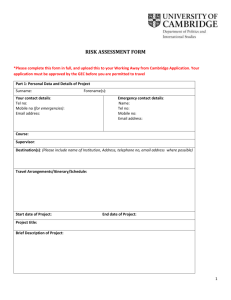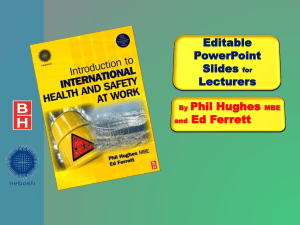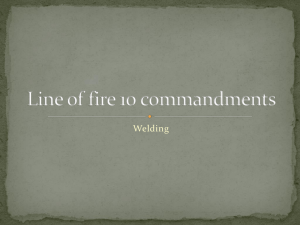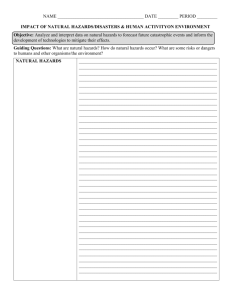System Safety Overview
advertisement
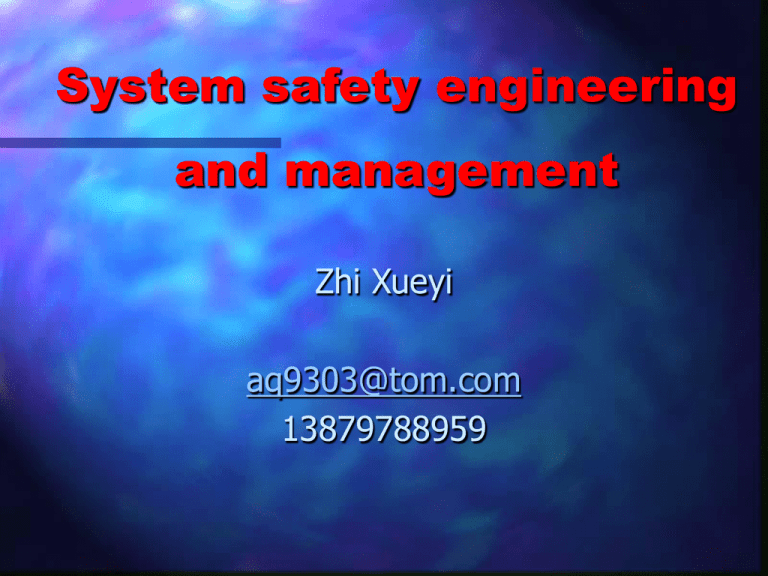
System safety engineering and management Zhi Xueyi aq9303@tom.com 13879788959 Questions 1 What is safe? 2 What is system safety? 3 How to obtain the safety? What is safe? 1) Freedom from accidents Freedom from those conditions that can cause death, injury, occupational illness or damage to or loss of equipment or property, or damage to environment. 2) The quality of a system that allows the system to function under a predetermined condition with an acceptable minimum of accidental loss What is system safety? The application of special technical and managerial skills in a systematic, forward looking manner to identify and control hazards throughout the life cycle of a project program, or activity. How to obtain the safety? • Engineering – Control hazards through product design or process change • Education – Train workers regarding all facets of safety – Impose on management that attention to safety pays off • Enforcement – Insure that internal and external rules, regulations, and standard operating procedures are followed by workers as well as management. Contents Introduction of system safety system safety terms Risk Management Preliminary Hazard Analysis or White Paper on Approaches to Safety Engineering Exercises Chapter1 Introduction of system safety 1.1 What is System Safety? What is “Safety” The goal of transforming the severity and likelihood of risk that is inherent in all human activity to lower, acceptable levels What is System Safety? System safety System Safety Philosophy Systems, Sub Systems and Elements Safety Attributes System Safety The application of special technical and managerial skills in a systematic, forward looking manner to identify and control hazards throughout the life cycle of a project program, or activity. 1.2 Systems Safety Philosophy Systems Safety is the application of special technical and managerial skills to identify, analyze, assess, and control hazards and risks and facilitate cultural changes within an organization. A systems is defined as a group of interrelated processes which are composed of, People, Procedures, Equipment, Materials, Tools Facilities, and Software, operating in a specific environment to perform a specific task or mission requirement for the USFS. Systems Safety covers the entire spectrum of risk management, from design of hardware to the culture and attitudes of the people involved. A system approach provides a logical structure for the problem solving. It views the entire systems as an integrated whole. System Safety Philosophy Simply said: System Safety is the review and validation of the Forest Service programs and procedures to determine regulatory compliance and the highest degree of safety possible. System Safety Philosophy System Safety is: Validation of Regulatory compliance Application of Safety Attributes Application of Risk Management 1.3 A System is ... People A set of Materials components that act together as SYSTEM Equipment a whole to Tools achieve a common goal. Software Facilities Procedures 14 Sub-systems An example of a sub-systems is: The training program by which the FS ensures personnel are trained to perform assigned duties in accordance with the FS needs and approved training program 1.4 System Safety Attributes Responsibility Authority Procedures Controls Process Measurement Interface Responsibility Responsibility Organization or person who owns the process and is answerable for the quality of the process. Authority Authority The organization or person who determines the course of action for a process. Procedures Procedures Documented or prescribed methods of accomplishing processes. Controls Checks or restraints that are designed into a process to ensure a desired result. Controls Process Measurement Process Measurement Measures or assesses information to identify, analyze and document potential problems with a process. Interfaces Interfaces Interactions between independent processes. System Safety Attributes Responsibility Interfaces Authority System Safety Attributes Process Measurement Procedures Controls 1.5 Why System Safety “It is insanity to continue doing the same thing over and over and expect the results to be different...” Albert Einstein 1.6 The Old way of doing business Fly-crash-fix-fly This old way of doing business means there will always be a next accident This method is referred to as BLOOD REGULATIONS! If we keep doing things the same old way, we will get the same results! 1.7 Are you safe Applying System Safety? System Safety is not a replacement S/S brings us to the next level in a forward thinking all encompassing accident prevention management tool. Practical Application Systems Safety – Can be global The upstart of a new flying business – Can be localized The launching of a single flight Each required a live safety system Old school of thought If it will cause loss of life, injury, or loss of equipment, don’t do it! Previous Approach Addressed only the operational segment of the safety system life cycle – Evident today (the way we do business) – Operation procedures are stagnant – Training programs aren’t totally applicable to the operations we do, (out dated) – Relies too much on pilot certification, experience, expertise and ability New school of thought (Systems Safety) If a function is necessary, then EVERYONE must set about to find the best and safest way to perform the funtion – No longer the pilot’s sole responsibility – Management must be involved – Find and implement the safest and best solution Today’s Approach Safety should begin at the design of the organization Safety is not at any cost Must be within the constraints of the real world 1.8 Systems Safety Program Objectives 1. To design safety to meet the job requirements and be practical. 2. Identify, evaluate, and eliminate hazards associated with all levels of the operation. 3. Use historical safety data. 4. Seek minimum risk. 5. Take actions to eliminate hazards. Program Objectives (continued) 6. Minimize re-invention 7. Implement program outlining actions to eliminate hazards. 8. Document significant safety data as lessons learned. 9. Document risk acceptance procedures and actions. Systems change is the one constant The Wright Brothers did not invent a B-747 It took many years of systems enhancements to evolve from the Wright Flyer to the B-747




![Environmental Health [Opens in New Window]](http://s3.studylib.net/store/data/007238128_1-c9d7669bae55fbb58c92a686b30e7950-300x300.png)

